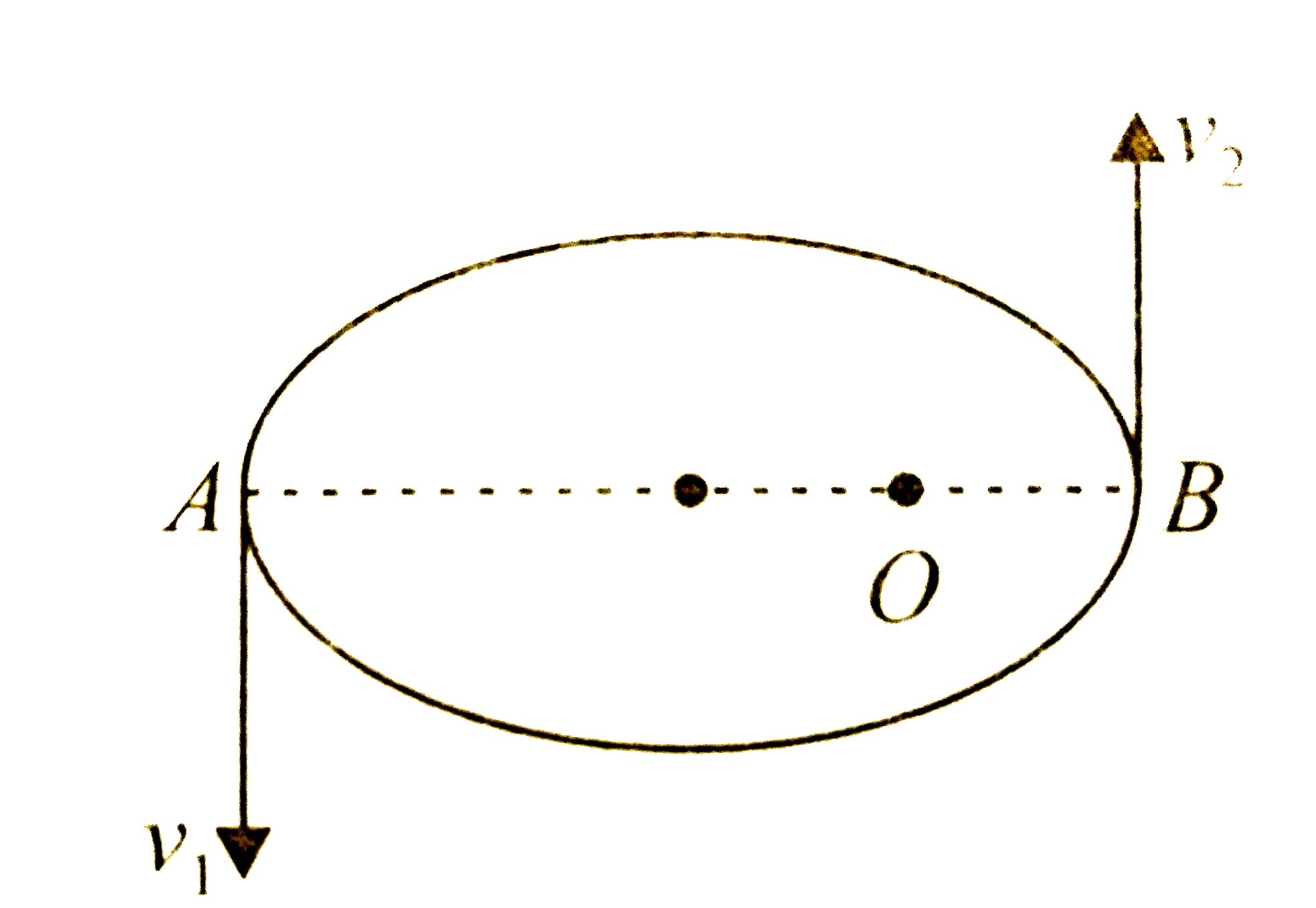A particle moves in a closed orbit around the origin, due to a force which is directed towards the origin. The de-broglie wavelength of the particles varies cyclically between two values . Which of the following statements are true?
The particle could be moving in a circular orbit with origin as centre.
The particle could be moving in an elliptical orbit with origin as its focus.
When the de Broglie wavelength is , the particle is nearer the origin than when its value is .
Both (a) and (c )
The correct Answer is:B
(b) : The de Broglie wavelength of the particle can be varying cyclically betweenb two values , if particle is moving in an elliptical orbit with origin as its one focus. Refer figure.
Let be the speed of particle at A and B jrespectively and origin is at focus O. If are the de Broglie wavelength associated with particle while moving at A and B respectively.
Then,
Since
From figure we note that origin O is close to B than A. Thus option (b) is true.

Topper's Solved these Questions
- BOOK - NCERT FINGERTIPSCHAPTER - DUAL NATURE OF RADIATION AND MATTER EXERCISE - Davisson And Germer Experiment3videos
DUAL NATURE OF RADIATION AND MATTER
- BOOK - NCERT FINGERTIPSCHAPTER - DUAL NATURE OF RADIATION AND MATTER EXERCISE - Higher Order Thinking Skills8videos
DUAL NATURE OF RADIATION AND MATTER
- BOOK - NCERT FINGERTIPSCHAPTER - DUAL NATURE OF RADIATION AND MATTER EXERCISE - Particle Nature Of Light : The Photon19videos
DUAL NATURE OF RADIATION AND MATTER
- BOOK - NCERT FINGERTIPSCHAPTER - CURRENT ELECTRICITYEXERCISE - Assertion And Reason15videos
CURRENT ELECTRICITY
- BOOK - NCERT FINGERTIPSCHAPTER - ELECTRIC CHARGES AND FIELDSEXERCISE - Assertion And Reason15videos
ELECTRIC CHARGES AND FIELDS
Similar Questions
The energy of a photon is E which is equal to the kinetic energy of a proton.If lambda1 be the de-Broglie wavelength of the proton and lambda2 be the wavelength of the photon,then the ratio (lambda_(1))/(lambda_(2)) is proportional to
View SolutionIf →aand→b are two unit vectors perpenicualar to each other and →c=λ1→a+λ2→b+λ3(→a×→b), then which of the following is (are) true ?
View Solution
Knowledge Check
- Question 1 - Select One
A particle moves in a closed orbit around the origin, due to a force which is directed towards the origin. The de-broglie wavelength of the particles varries cyclists between two valuse λ1,λ2withλ1>λ2. Which of the following statements are true?
AThe particle could be moving in a circular orbit with origin as centreBThe particle could be moving in an elliptic orbit with origin as its focusCWhen the de-broglie wavelength is λ1, the particle is nearer the origin than when its value is λ2DWhen the de-broglie wavelength is λ2, the particle is nearer the origin than when its value is λ1 - Question 2 - Select One
The de-Broglie wavelength of an electron, an α -particle and a proton are λe,λα,λp. Which is wrong from the following:
Aλe>λpBλe<λpCλp>λαDλe>λp>λα - Question 3 - Select One
The de-Broglie wavelength of an electron, an α-particle and a proton are λe,λa,λp. Which is wrong from the following?
Aλe>λpBλe<λpCλp>λαDλe>λp>λα
Two sound waves of wavelengths λ1 and λ2(λ2>λ1) produces nbeats/s , the speed of sound is
View SolutionA particle of mass 3 m at rest decay Into two particles of masses m and 2m having non-zero velocities. What is the ratio of the de-Broglie wavelengths of the particle (λ1/λ2).
View SolutionThe wavelength of electron waves in two orbits (λ1:λ2)
View SolutionA charged particle is associated from rest through a certain potential difference. The de-Broglie wavelength is λ1 when it is accelerated through V1 and is λ2 when accelerated through V2. The ratio λ1/λ2 is
View SolutionIf the kinetic energy of the particle having wavelength ‘ lambda’ is increased to 25 times its previous value, then the change in de-Broglie wavelength of the particle is :
View Solution

